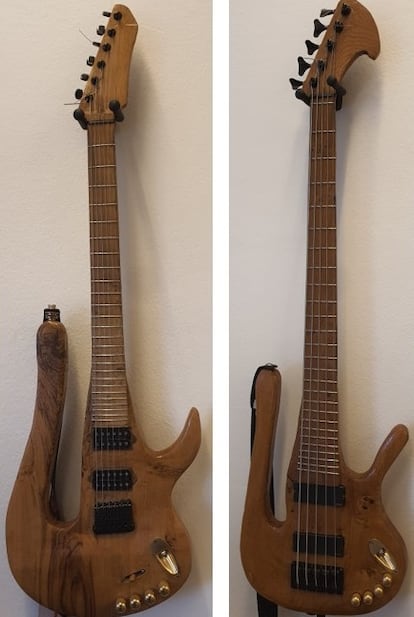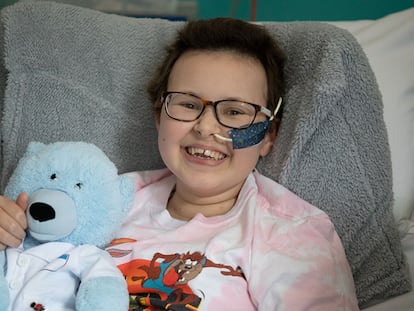Morten Meldal, Nobel prize winner: ‘Click chemistry will help us defeat cancer and Alzheimers’
The co-inventor of a new, enormously simple type of molecular reaction explains how they can revolutionize the search for new drugs and materials

The Danish scientist Morten Meldal is one of the inventors of a new kind of chemistry, click chemistry. The idea came from a staggering statistic: the number of simple chemical compounds that could be converted into a new drug is 10 to the 62nd power, or: 100,000,000,000,000,000,000,000,000,000,000,000,000,000,000,000,000,000,000,000,000. That’s 100 times more than the number of stars in the entire universe. Among these could be a cure for Alzheimers and many other illnesses. For nature, with its timelines of billions of years, generating all those compounds isn’t a problem, but for humans, producing and studying them seems like an impossible challenge.
In the year 2000, the chemist Barry Sharpless published a scientific manifesto that invited the search for a new simple, cheap chemistry that used water as a base and worked at room temperature. He called it “click” chemistry, because it involved combining two molecules like fastening a seatbelt buckle.
A year later, Meldal and Sharpless discovered, independently and almost simultaneously, copper-catalyzed azide-alkyne cycloaddition. The complicated name refers to a simple reaction that combines two molecules to create a third with new properties. The process was a giant leap in contemporary chemistry, because it worked almost 100% of the time and did not create waste. It was the jewel in the crown of the new click chemistry. Almost at the same time, the chemist Carolyn Bertozzi came up with the idea of taking those principles to biology and human cells, creating bioorthogonal chemistry. Suddenly, studying all the possible compounds in the universe was a little easier.
In just 20 years, Meldal says, click chemistry has silently conquered the world. Currently, these reactions allow the identification of compounds on the surface of malicious cells and send other molecules that destroy them, an enormously promising technique for annihilating malignant tumors. Bertozzi, Sharpless and Meldal won the Nobel Prize in Chemistry last year for their exceptional inventions.
Meldal, who was once an avid painter and now plays in a rock band with guitars that he makes himself, visited Madrid to give a presentation to the Ramón Areces Foundation. In this interview, the Nobel winner explains how click chemistry can help to improve medications, energy and sustainability, and explains that chemistry is sometimes more art than science.
Question. Why did you decide to become a chemist?
Answer. My father was a businessman and my mother was a painter, the daughter of farmers. She had this sense of Danish tradition and she used dead animals in her paintings. I spent a lot of time on my grandparents’ farm, in the meadows and forests and beaches. It was the most privileged place for a child to grow up. I had this sensation for nature. What is it? Why is it so beautiful? How does everything fit so well together? Eventually I found that chemistry could give me the explanation of everything, not only here, but the whole universe.
Q. Does the chemistry that you develop imitate nature?
A. In nature, you have very complex situations where a lot of different functionalities come together and produce the mechanisms that allow us to live, making cells come together as multicellular organisms. This complexity is very difficult for us to imitate in medicine. But with click chemistry, we are able to take different functions from nature and put them together like a Lego building set. All the big chemical companies today have a section for click reactions. If you are a biologist, you just look at the catalogue and you find the click reaction that you need.
Q. How many reactions are known?
A. There are about 50 different types to start to build with.
Q. What applications exist?
A. Cancer is an obvious one, or chronic diseases like Alzheimers, for example. It is possible to recognize a bacteria and then have something kill the bacteria. If you can do that very specifically, you can have an antibiotic without any side effects. You can create new materials to produce electricity using the light in photovoltaic cells.
Q. Do any of those applications exist yet?
A. Not yet. All of these things take a long time to develop, in particular in medicine. But I know of about 40 drugs that are in the pipelines, some of them for cancer.
Q. How do they work?
A. You incorporate one of the click components selectively on the cancer cells. The other components carry a cytotoxic component, which is released during the reaction. So that’s one way to do it. And another way is by using a radioligand associated with a molecule that recognizes cancer cells, in order to kill them with radiation much more precisely, without damaging healthy cells.
Q. What are you working on now?
A. Currently we are trying to create completely artificial proteins. We have micro-proteins that are made up of all sorts of amino acids and increase our ability to design from the 20 amino acids in nature to 5,000. We use computational chemistry to model new proteins that fold up and have biological function. We use click reactions to maintain the proteins’ structure. Our ultimate aim is to be able to make it into medically active drugs that imitate enzymes. Most current drugs are inhibitors, which means that you have to have a fairly large amount in your body.
Q. You used to work in programming, and now you design new molecules. There is a lot of buzz about artificial intelligence, and we have been hearing apocalyptic messages about this technology. Do you think AI is that dangerous?
A. There are so many different types of AI. You start with machine learning, and you end up with very sophisticated AI that’s able to make programs by itself and has sort of a consciousness that makes us prefer its own existence over other things. That’s actually the dangerous part. It’s also very defense-oriented. It started out in the defense industry, and it’s going to be problematic there because if you want artificial intelligence to make decisions in the case of crisis or war, it has to be able to make those decisions autonomously. That’s not good. We can make things that wreak havoc in the world. We have done it with nuclear weapons and the environmental crisis.
Q. You are very concerned about the planet’s sustainability and the growing consumption of resources. Do you think we will be able to move past burning fossil fuels for energy?
A. There is a very rapid process in development for transitioning to green energy. Hydrogen is going to be a big hit in the next five, 10 years, in my opinion, because it’s such a clean conversion. Hydrogen can be produced green or it can be produced from fossil fuels. If it’s produced from fossil fuels, you have a fairly controlled process compared to the combustion engines of our cars. I think that green energy is going to be a really big issue in the future, and we are going to get rid of fossil fuels in 20 to 40 years.

Q. You like to talk about pleasure-based teaching. What is that?
A. It should be joyful for children to learn. I think it’s very important that we teach chemistry early on, because everything that we have around us is actually chemistry or molecules. We need to be able to understand this world, and the way to understand it is to pierce into it and look at it. We can do that today with all the powerful animations that we have. We can make this accessible to the world, and I think we should do that, in particular for young kids in school. It’s just as important to me as, uh, reading and writing to understand what we are handling. It’s important for everything, for our understanding of our own life and health, for political processes, for conflict formation, for the way that we are able to operate as professionals in our jobs, particularly as a chemist, but also as a mason or a baker or a blacksmith. Whatever you’re doing, you’re working with chemistry.
Q. You painted when you were younger, and you still play in a rock band. Can you tell me about your instruments?
A. In Denmark, 30 years ago, I helped out a man who had a big castle in Denmark and a lot of forest. I helped him put this forest into Excel sheets so he would know what to do with his wood. So he gave me a huge oak tree as a gift. It was cut into sheets, and I had this wood in my garage. So I took it and started to make guitars that I designed. I like to play guitar. Often when my wife falls asleep, I’m in the basement for half an hour playing before I go to bed.
Sign up for our weekly newsletter to get more English-language news coverage from EL PAÍS USA Edition
Tu suscripción se está usando en otro dispositivo
¿Quieres añadir otro usuario a tu suscripción?
Si continúas leyendo en este dispositivo, no se podrá leer en el otro.
FlechaTu suscripción se está usando en otro dispositivo y solo puedes acceder a EL PAÍS desde un dispositivo a la vez.
Si quieres compartir tu cuenta, cambia tu suscripción a la modalidad Premium, así podrás añadir otro usuario. Cada uno accederá con su propia cuenta de email, lo que os permitirá personalizar vuestra experiencia en EL PAÍS.
¿Tienes una suscripción de empresa? Accede aquí para contratar más cuentas.
En el caso de no saber quién está usando tu cuenta, te recomendamos cambiar tu contraseña aquí.
Si decides continuar compartiendo tu cuenta, este mensaje se mostrará en tu dispositivo y en el de la otra persona que está usando tu cuenta de forma indefinida, afectando a tu experiencia de lectura. Puedes consultar aquí los términos y condiciones de la suscripción digital.
More information
Archived In
Últimas noticias
Most viewed
- Sinaloa Cartel war is taking its toll on Los Chapitos
- Oona Chaplin: ‘I told James Cameron that I was living in a treehouse and starting a permaculture project with a friend’
- Reinhard Genzel, Nobel laureate in physics: ‘One-minute videos will never give you the truth’
- Why the price of coffee has skyrocketed: from Brazilian plantations to specialty coffee houses
- Silver prices are going crazy: This is what’s fueling the rally










































